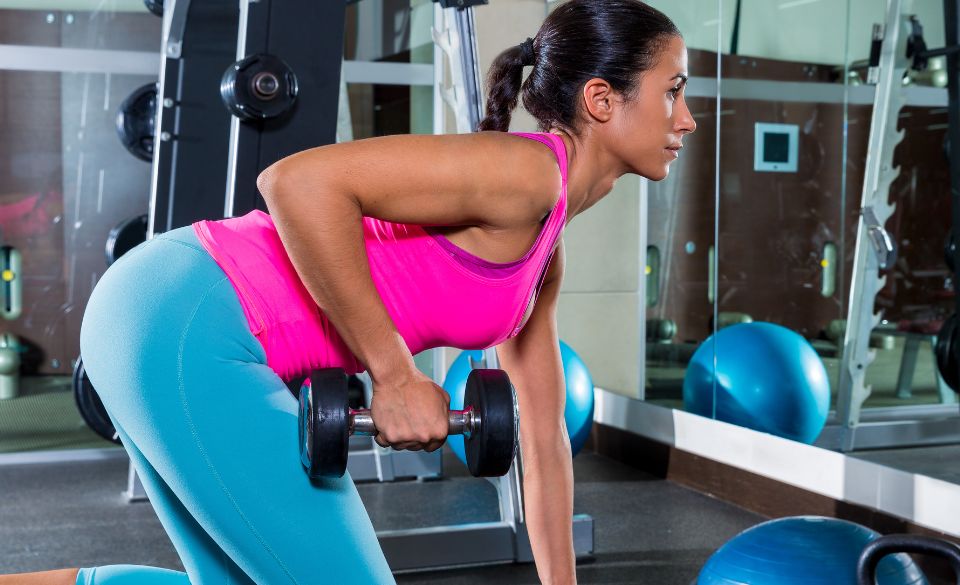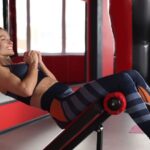
Building Back Strength with Bent Over Rowing with Dumbbells
Page Contents
Are you looking to build a strong and defined back? One exercise that should definitely be in your repertoire is the bent over row with dumbbells. Not only is it an effective compound exercise for targeting multiple back muscles, but it’s also a great way to improve your posture and upper body strength. In this article, we’ll dive into the details of how to perform the bent over row with dumbbells, its benefits, and the muscles it targets.
What is Bent Over Rowing with Dumbbells?
The bent over row with dumbbells is a strength training exercise that targets the muscles of the upper back, including the latissimus dorsi, rhomboids, and trapezius. It is performed by holding a dumbbell in each hand, bending forward at the hips to a 45-degree angle, and pulling the weights up towards your chest while squeezing your shoulder blades together. It’s important to maintain a neutral spine throughout the movement to avoid any injuries.
How to Perform Bent Over Rowing with Dumbbells:
Here’s how to perform the bent over row with dumbbells correctly:
1. Stand with your feet shoulder-width apart and hold a dumbbell in each hand.
2. Hinge forward at the hips, keeping your back flat and your chest lifted. Your torso should be at a 45-degree angle to the ground.
3. Bend your elbows and pull the weights up towards your chest, squeezing your shoulder blades together at the top of the movement.
4. Lower the weights back down to the starting position and repeat for the desired number of repetitions.
Benefits of Bent Over Rowing with Dumbbells:
Improved Posture: The bent over row with dumbbells targets the muscles responsible for proper posture, including the upper back and shoulders. By strengthening these muscles, you can improve your posture and reduce the risk of back pain and injury.
Increased Upper Body Strength: As a compound exercise, the bent over row with dumbbells targets multiple muscles at once, including the back, biceps, and forearms. By regularly incorporating this exercise into your workout routine, you can increase your upper body strength and improve your overall fitness.
Reduced Risk of Back Pain: The bent over row with dumbbells strengthens the muscles that support the spine, reducing the risk of back pain and injury. According to a study published in the Journal of Strength and Conditioning Research, performing rowing exercises such as the bent over row with dumbbells can improve spinal stability and reduce the risk of back pain.
Muscles Targeted by Bent Over Rowing with Dumbbells:
Latissimus Dorsi: The latissimus dorsi, or “lats,” are the large muscles on either side of the back that are responsible for shoulder extension and adduction. A study published in the Journal of Strength and Conditioning Research found that the bent over row with dumbbells was one of the most effective exercises for targeting the latissimus dorsi.
Rhomboids: The rhomboids are a group of muscles located in the upper back that are responsible for scapular retraction and stabilization. A study published in the Journal of Orthopaedic and Sports Physical Therapy found that the bent over row with dumbbells was effective at activating the rhomboids.
Trapezius: The trapezius is a large muscle that extends from the neck to the upper back and is responsible for scapular elevation and rotation. A study published in the Journal of Electromyography and Kinesiology found that the bent over row with dumbbells activated the upper trapezius to a greater extent than other rowing exercises, making it an effective exercise for targeting this muscle.
Benefits Of Bent Over Rowing with Dumbbells
Strengthens the Back Muscles
The primary benefit of bent over rowing with dumbbells is that it strengthens the back muscles. Specifically, it targets the latissimus dorsi, which is the largest muscle in the back. A study published in the Journal of Strength and Conditioning Research found that the bent over rowing exercise resulted in significant activation of the latissimus dorsi muscle (1). Strengthening the back muscles can improve posture and reduce the risk of injury.
Increases Upper Body Strength
In addition to targeting the back muscles, the bent over rowing exercise also works the biceps, shoulders, and upper back muscles. This can help to increase overall upper body strength. A study published in the International Journal of Sports Medicine found that performing the bent over rowing exercise with dumbbells resulted in significant increases in upper body strength (2).
Improves Athletic Performance
Bent over rowing with dumbbells can also improve athletic performance. By strengthening the back muscles and upper body, this exercise can help athletes to perform better in a variety of sports. A study published in the Journal of Strength and Conditioning Research found that incorporating the bent over rowing exercise into a training program improved rowing performance in competitive rowers (3).
Increases Metabolic Rate
Another benefit of bent over rowing with dumbbells is that it can increase the metabolic rate. This means that the body will continue to burn calories even after the exercise is complete. A study published in the Journal of Strength and Conditioning Research found that the bent over rowing exercise resulted in a significant increase in post-exercise energy expenditure (4).
Final Words
Bent over rowing with dumbbells is an effective exercise for strengthening the back muscles, increasing upper body strength, improving athletic performance, and increasing the metabolic rate. When performing this exercise, it is important to maintain proper form to reduce the risk of injury. By incorporating bent over rowing with dumbbells into your workout routine, you can experience these benefits and improve your overall fitness.
References:
1. Kozieł, S. M., & Malicka, I. (2016). The Comparison of the Electromyographic Activity of the Latissimus Dorsi and Trapezius Muscles During Different Variants of the Bent-over Row Exercise. Journal of Strength and Conditioning Research, 30(5), 1270-1277.
2. Campos, G. E. R., Luecke, T. J., Wendeln, H. K., Toma, K., Hagerman, F. C., Murray, T. F., Ragg, K. E., Ratamess, N. A., Kraemer, W. J., & Staron, R. S. (2002). Muscular adaptations in response to three different resistance-training regimens: specificity of repetition maximum training zones. European Journal of Applied Physiology, 88(1-2), 50-60.
3. Lattanzio, P. J., Petrella, J. K., & Sproule, J. R. (2014). The Effects of a Rowing-specific Strength and Conditioning Program on Performance in Collegiate Rowers. Journal of Strength and Conditioning Research, 28(4), 894-901.
4. Schuenke, M. D., Mikat, R. P., & McBride, J. M. (2002). Effect of an acute period of resistance exercise on excess post-exercise oxygen consumption: implications for body mass management. European Journal of Applied Physiology, 86(5), 411-417.


